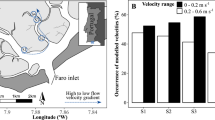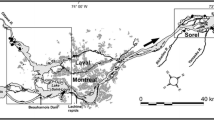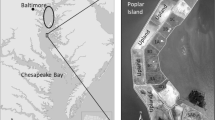Abstract
The role of in-stream aquatic vegetation as ecosystem engineers in the distribution of organic matter was investigated in the Okavango Delta, one of the world’s largest oligotrophic wetlands. The Okavango channel beds are covered up to 50% with submerged macrophyte patches. By accumulating and concentrating organic matter in the sediments below the patches, macrophytes are likely able to locally forestall a deficiency of nutrients. Up to 21 times more N, 18 times more C, 13 times more P and 6 times more Si can be found in vegetated sediments compared to non-vegetated sediments. Nutrient specific accumulation relates to its relative scarcity in the overlaying water. There is a depletion of dissolved N relative to P, whereas Si is relatively abundant. The Okavango Delta water can generally be characterised as oligotrophic based on plant species composition (e.g. presence of carnivorous plants and absence of floating plants), low plant N:P ratios, and low nutrient- and element-concentrations. Local mineralization and intensified nutrient cycling in the sediments is hypothesized to be crucial for the macrophytes’ survival because it provides a key source of the essential nutrients which plants otherwise cannot obtain in sufficient quantities from the nutrient poor water. By engineering the ecosystem as such, channel vegetation also retards the loss of elements and nutrients to island groundwater flow, contributing to one of the key processes driving the high productivity of the Okavango Delta, making it unique among its kind.





Similar content being viewed by others
References
Adamec L (1997) Mineral nutrition of carnivorous plants: a review. Bot Rev 63:273–299
Alfredsson H, Hugelius G, Clymans W, Stadmark J, Kuhry P, Conley DJ (2015) Amorphous silica pools in permafrost soils of the Central Canadian Arctic and the potential impact of climate change. Biogeochemistry 1–19
Appleton CC, Curtis BA, Alonso LE, Kipping J (2003) Chap. 4: Freshwater Invertebrates of the Okavango Delta, Botswana. In: Alonso LE, Nordin L-A (eds.) A rapid biological assessment of the aquatic ecosystems of the Okavango Delta, Botswana: high Water Survey Conservation. International Center for Applied Biodiversity Science, Washington, DC, pp 58–68
Bal K, Brion N, Woulé-Ebongué V, Schoelynck J, Jooste A, Barrón C, Dehairs F, Meire P, Bouma T (2013) Influence of hydraulics on the uptake of ammonium in two freshwater aquatic plants. Freshw Biol 58:2452–2463
Battin TJ, Kaplan LA, Findlay S, Hopkinson CS, Marti E, Packman AI, Newbold JD, Sabater, F (2008) Biophysical controls on organic carbon fluxes in fluvial networks. Nat Geosci 1: 95–100
Berg B, McClaugherty C (2003) Plant litter: decomposition, humus formation, carbon sequestration. Springer, Berlin
Bouma TJ, van Duren LA, Temmerman S, Claverie T, Blanco-Garcia A, Ysebaert T, Herman PMJ (2007) Spatial flow and sedimentation patterns within patches of epibenthic structures: combining field, flume and modelling experiments. Cont Shelf Res 27:1020–1045
Caraco N, Cole J, Findlay S, Wigand C (2006) Vascular plants as engineers of oxygen in aquatic systems. Bioscience 56:219–225
Cotton JA, Wharton G, Bass JAB, Heppell CM, Wotton RS (2006) The effects of seasonal changes to in-stream vegetation cover on patterns of flow and accumulation of sediment. Geomorphology 77:320–334
Cronberg G, Gieske A, Martins E, Stenstrom I (1996) Hydrobiological studies of the Okavango Delta and Kwando–Linyanti–Chobe River, Botswana. Surface water quality analysis. Botsw Notes Rec 27:151–226
Dallas HF, Mosepele B (2006) A preliminary survey and analysis of the spatial distribution of aquatic invertebrates in the Okavango Delta, Botswana. Afr J Aquat Sci 32:1–11
DeMaster DJ (1981) The supply and accumulation of silica in the marine-environment. Geochim et Cosmochim Acta 45:1715–1732
Dobson M, Magana A, Mathooko JM, Ndegwa FK (2002) Detritivores in Kenyan highland streams: more evidence for the paucity of shredders in the tropics? Freshw Biol 47:909–919
Ellery WN, Tacheba B (2003) Chap. 5: Floristic diversity of the Okavango Delta, Botswana. In: Alonso LE, Nordin L-A (eds) A Rapid Biological Assessment of the Aquatic Ecosystems of the Okavango Delta, Botswana: High Water Survey Conservation International Center for Applied Biodiversity Science Washington, DC p69–96
Emsens W-J, Schoelynck J, Grootjans AP, Struyf E, Van Diggelen R (2016) Eutrophication alters Si cycling and litter decomposition in wetlands. Biogeochemistry 130:1–11
Fisher SG, Grimm NB, Marti E, Holmes RM, Jones JB (1998) Material spiraling in stream corridors: A telescoping ecosystem model. Ecosystems 1:19–34
Frings PJ, De La Rocha C, Struyf E, van Pelt D, Schoelynck J, Hudson MM, Gondwe MJ, Wolski P, Mosimane K, Gray W, Schaller J, Conley DJ (2014) Tracing silicon cycling in the Okavango Delta, a sub-tropical flood-pulse wetland using silicon isotopes. Geochim et Cosmochim Acta 142 :132–148
Gessner MO, Chauvet E, Dobson M (1999) A perspective on leaf litter breakdown in streams. Oikos 85:377–384
Grasshoff K, Ehrhardt M, Kremling K (1983) Methods of seawater analysis. Wiley-VCH, Germany
Green JC (2005) Modelling flow resistance in vegetated streams: review and development of new theory. Hydrol Processes 19:1245–1259
Gumbricht T, McCarthy J, McCarthy TS (2004) Channels, wetlands and islands in the Okavango Delta, Botswana, and their relation to hydrological and sedimentological processes. Earth Surf Process Landf 29:15–29
Gurnell AM (2014) Plants as river system engineers. Earth Surf Process Landf 39:4–25
Hagerthey SE, Cole JJ, Kilbane D (2010) Aquatic metabolism in the Everglades: Dominance of water column heterotrophy. Limnol Oceanogr 55:653–666
Heiri O, Lotter AF, Lemcke G (2001) Loss on ignition as a method for estimating organic and carbonate content in sediments: reproducibility and comparability of results. J Paleolimnol 25:101–110
Hicks DM, Duncan MJ, Lane ST, Tal M, Westway R (2008) Contemporary morphological change in braided gravel–bed river: new developments from field and laboratory studies, with particular reference to the influence of riparian vegetation. In: Habersack H, Piégay H, Rinaldi M (eds.) Gravel-bed Rivers VI: from process understanding to river restoration (developments in earth surface processes). Elsevier, Amsterdam, pp 557–584
Horvath TG (2004) Retention of particulate matter by macrophytes in a first-order stream. Aquat Bot 78:27–36
Humphries M, McCarthy T, Cooper G, Stewart RA, Stewart RD (2014) The role of airborne dust in the growth of tree islands in the Okavango Delta, Botswana. Geomorphology 206:307–317
Irons JG, Oswood MW, Stout RJ, Pringle CM (1994) Latitudinal patterns in leaf-litter breakdown—is temperature really important? Freshw Biol 32:401–411
Janauer GA, Schmidt-Mumm U, Reckendorfer W (2013) Ecohydraulic and aquatic macrophytes: assessing the relationship in river floodplains. In: Maddock I, Harby A, Kemp P, Wood P (eds.) Ecohydraulics: an integrated approach. Wiley, Chichester, pp 245–259
Jones CG, Lawton JH, Shachak M (1994) Organisms as ecosystem engineers. Oikos 69:373–386
Kleeberg A, Kohler J, Sukhodolova T, Sukhodolov A (2010) Effects of aquatic macrophytes on organic matter deposition, resuspension and phosphorus entrainment in a lowland river. Freshw Biol 55:326–345
Koerselman W, Meuleman AFM (1996) The vegetation N:P ratio: a new tool to detect the nature of nutrient limitation. J Appl Ecol 33:1441–1450
Krah M, McCarthy TS, Huntsman-Mapila P, Wolski P, Annegarn H, Sethebe K (2006) Nutrient budget in the seasonal wetland of the Okavango Delta, Botswana. Wetlands Ecol Manage 14:253–267
Larsen LG, Harvey JW (2010) How vegetation and sediment transport feedbacks drive landscape change in the Everglades and wetlands worldwide. Am Nat 176(3):E66–E79
Mackay AW, Davidson T, Wolski P, Mazebedi R, Masamba WRL, Huntsman-Mapila P, Todd M (2011) Spatial and seasonal variability in surface water chemistry in the Okavango Delta, Botswana: a multivariate approach. Wetlands 31:815–829
Madsen TV, Cedergreen N (2002) Sources of nutrients to rooted submerged macrophytes growing in a nutrient-rich stream. Freshw Biol 47:283–291
Masese FO, Kitaka N, Kipkemboi J, Gettel GM, Irvine K, McClain ME (2014) Macroinvertebrate functional feeding groups in Kenyan highland streams: evidence for a diverse shredder guild. Freshw Sci 33:435–450
McCarthy TS, Stanistreet IG, Cairncross B (1991) The sedimentary dynamics of active fluvial channels on the Okavango fan, Botswana. Sedimentology 38:471–487
McCarthy TS, Ellery WN, Dangerfield JM (1998) The role of biota in the initiation and growth of islands on the floodplain of the Okavango alluvial fan, Botswana. Earth Surf Process Landf 23:291–316
McCarthy JM, Gumbricht T, McCarthy T, Frost P, Wessels K, Seidel F (2003) Flooding patterns of the Okavango wetland in Botswana between 1972 and 2000. Ambio 32:453–457
McCarthy TS, Humphries MS, Mahomed I, Le Roux P, Verhagen BT (2012) Island forming processes in the Okavango Delta, Botswana. Geomorphology 179:249–257
Mladenov N, McKnight DM, Wolski P, Ramberg L (2005) Effects of annual flooding on dissolved organic carbon dynamics within a pristine wetland, the Okavango Delta, Botswana. Wetlands 25:622–638
Mosimane K, Struyf E, Gondwe MJ, Frings P, van Pelt D, Wolski P, Schoelynck J, Schaller J, Conley DJ, Murray-Hudson M (2017) Variability in chemistry of surface and soil waters of an evapotranspiration-dominated flood-pulsed wetland: solute processing in the Okavango Delta, Botswana. Water SA 43(1):104–115
R Core Team (2013) R: a language and environment for statistical computing. R Foundation for Statistical Computing, Vienna. http://www.R-project.org
Ramberg L, Wolski P (2008) Growing islands and sinking solutes: processes maintaining the endorheic Okavango Delta as a freshwater system. Plant Ecol 196:215–231
Sand-Jensen K (1998) Influence of submerged macrophytes on sediment composition and near-bed flow in lowland streams. Freshw Biol 39:663–679
Schaller J, Struyf E (2013) Silicon controls microbial decay and nutrient release of grass litter during aquatic decomposition. Hydrobiologia 709:201–212
Schaller J, Schoelynck J, Struyf E, Meire P (2016) Silicon affects nutrient content and ratios of wetland plants. Silicon 8:479–485
Schoelynck J, Struyf E (2016) Silicon in aquatic vegetation. Funct Ecol 30:1323–1330
Schoelynck J, De Groote T, Bal K, Vandenbruwaene W, Meire P, Temmerman S (2012) Self-organised patchiness and scale-dependent bio-geomorphic feedbacks in aquatic river vegetation. Ecography 35:760–768
Schoelynck J, Meire D, Bal K, Buis K, Troch P, Bouma T, Meire P, Temmerman S (2013) Submerged macrophytes avoiding a negative feedback in reaction to hydrodynamic stress. Limnologica 43:371–380
Schoelynck J, Bal K, Verschoren V, Penning E, Struyf E, Bouma T, Meire D, Meire P, Temmerman S (2014) Different morphology of Nuphar lutea in two contrasting aquatic environments and its effect on ecosystem engineering. Earth Surf Process Landf 39:2100–2108
Struyf E, Conley DJ (2012) Emerging understanding of the ecosystem silica filter. Biogeochemistry 107:9–18
Struyf E, Mosimane K, Van Pelt D, Murray-Hudson M, Meire P, Frings P, Wolski P, Schaller J, Gondwe MJ, Schoelynck J, Conley DJ (2015) The role of vegetation in the Okavango Delta silica sink. Wetlands 5:171–181
Tal M, Paola C (2007) Dynamic single-thread channels maintained by the interaction of flow and vegetation. Geology 35:347–350
Taylor BR, Parkinson D, Parsons WFJ (1989) Nitrogen and lignin content as predictors of litter decay-rates—a microcosm test. Ecology 70:97–104
Temmerman S, Bouma TJ, Van de Koppel J, Van der Wal DD, De Vries MB, Herman PMJ (2007) Vegetation causes channel erosion in a tidal landscape. Geology 35:631–634
Thompson K (1976) The primary productivity of African Wetlands, with particular reference to the Okavango Delta, Paper presented at the Symposium on the Okavango Delta and its future utilization, Botswana Society, National Museum, Gaborone, Botswana
van Wesenbeeck BK, van de Koppel J, Herman PMJ, Bouma TJ (2008) Does scale-dependent feedback explain spatial complexity in salt-marsh ecosystems? Oikos 117:152–159
Vannote RL, Minshall GW, Cummins KW, Sedell JR, Cushing CE (1980) River Continuum Concept. Can J Fish Aquatic Sci 37:130–137
Walinga I, Van Vark W, Houba VJG, Van Der Lee JJ (1989) Plant analysis procedures. Soil and Plant Analysis, Part 7. Wageningen, NL
Webster JR, Benfield EF (1986) Vascular plant breakdown in fresh-water ecosystems. Annu Rev Ecol Syst 17:567–594
Wetzel PR, van der Valk AG, Newman S, Gawlik DE, Gann TT, Coronado-Molina CA, Childers DL, Sklar FH (2005) Maintaining tree islands in the Florida Everglades: nutrient redistribution is the key. Front Ecol Environ 3(7):370–376
Wolski P, Savenije HHG, Murray-Hudson M, Gumbricht T (2006) Modelling of the flooding in the Okavango Delta, Botswana, using a hybrid reservoir-GIS model. J Hydrol 331:58–72
Acknowledgements
We would like to thank several funding agencies for their funding contributions: University of Botswana Office of Research and Development, EU Marie Curie Program (Hobits), National Geographic Explorer Grant, the Swedish National Science Foundation (VR) and the Knut and Alice Wallenberg Foundation. This research was carried out under Permit EWT 8/36/4 XVI(6) from the Government of Botswana. We would like to thank BELSPO for funding the project SOGLO. J.S. is a postdoctoral fellow of FWO (project no. 12H8616N) and thanks the FWO for a travel grant.
Author information
Authors and Affiliations
Corresponding author
Electronic supplementary material
Supplementary material 1 (MP4 158123 KB)
Rights and permissions
About this article
Cite this article
Schoelynck, J., Schaller, J., Murray-Hudson, M. et al. The trapping of organic matter within plant patches in the channels of the Okavango Delta: a matter of quality. Aquat Sci 79, 661–674 (2017). https://doi.org/10.1007/s00027-017-0527-2
Received:
Accepted:
Published:
Issue Date:
DOI: https://doi.org/10.1007/s00027-017-0527-2




